Houzz Tour: Connecting to the Landscape in Melbourne
Moonah trees can live for hundreds of years. Their name alone conveys a sense of mysticism, but it is their ancient ties to the coastal Barwon Heads region of Australia that have made them local legends. As the trees age, their bark becomes increasingly gnarled and twisted, responding to the surrounding environment and conditions. Like the cypress trees of Monterey, the baobab trees of Madagascar and the giant sequoias of California, these are regional icons, part of the landscape.
When architecture firm Auhaus was hired to build a house in Barwon Heads last year, they embraced these local natives: framing views of them, emulating their form and connecting with the landscape of the revered moonah tree. “The house was designed in conjunction with the landscape, and the two parts are inseparable,” says project architect Kate Fitzpatrick. “We wanted the house to be experienced as an extension of the site.”
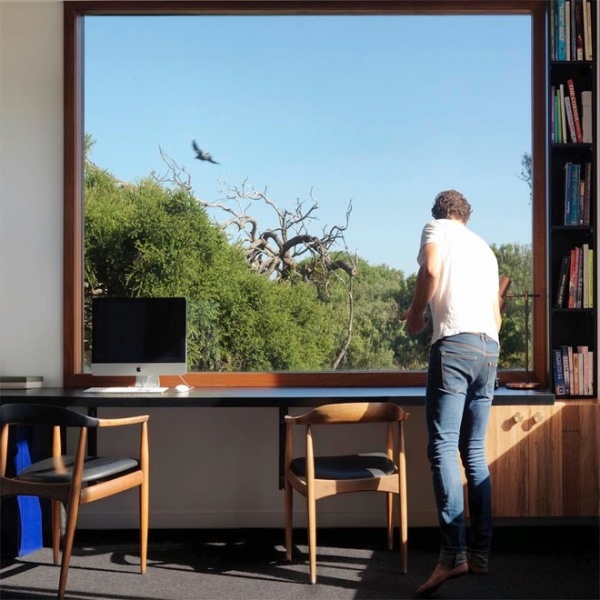
Houzz at a Glance
Location: Barwon Heads, a coastal town on the Great Ocean Road in Victoria, Australia
Size: 2,906 square feet (270 square meters); 1,238 square feet (115 square meters) of decks
Year built: Fall of 2013
The home’s study sits on its top floor, overlooking the moonahs behind the house. Thick, shrubby dune vegetation grows between the house and a nearby golf course. Fitzpatrick framed this view with one large window. “We wanted to create serene yet engaging interior spaces that make you deeply aware of the space you are in and the landscape outside,” She says.
Built-in desk and bookcase is black laminate. The cabinets under are blackbutt veneer. Floors are Tretford goat hair carpet.
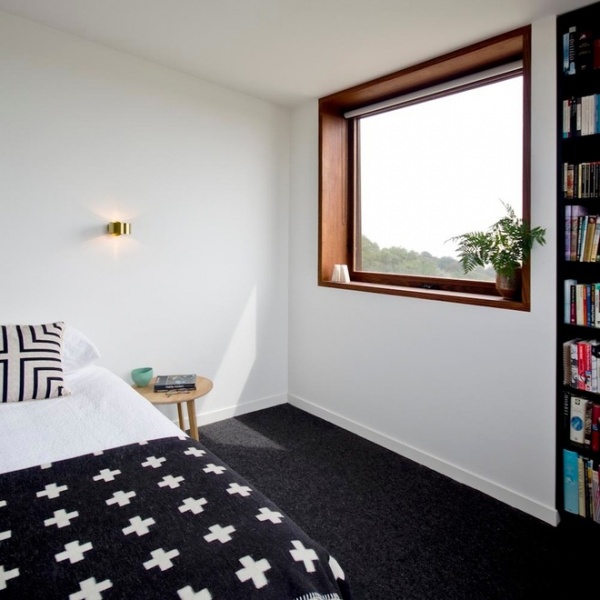
The master bedroom joins the study on the top floor. The architects placed windows to capture particular views. “We wanted the house to feel like a sanctuary surrounded by landscape, and to that end we tried to remove views to the neighboring houses as much as possible,” says Fitzpatrick.
The homeowners, a couple in their ’50s, bought this property to live in year-round and expect that their children and future grandchildren will visit every summer. So they wanted a home that would accommodate three generations comfortably. Fitzpatrick arranged the home’s three levels for this. When there are no visitors, the homeowners need to access only the top two floors.
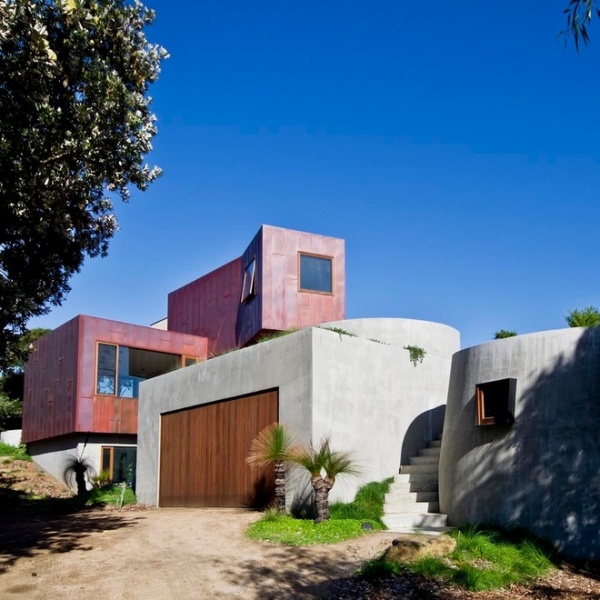
The site slopes up a little more than 16 feet (5 meters) from front to rear. Behind the house the grade rises an additional 6½ feet (2 meters) to the adjacent golf course. From the street visitors are led up a series of outdoor stairs, decks and winding walkways to the second floor, which is where the front door is.
“The slope meant that a three-story build was required in order to achieve views of the golf course,” says Fitzpatrick. Only the top floor really captures the surrounding views. Part of the first floor is carved into the hillside, so a big part of the architects’ challenge was avoiding a windowless, cave-like house.
The architects also didn’t want the house to impose itself too heavily on the landscape and surrounding neighborhood. “Breaking up the building into various forms allowed us plenty of internal living space without creating visual bulk from the street — treating the building form almost like a landscape in itself,” says Fitzpatrick.
Facade: copper cladding, vertical wood timber, poured-in-place concrete
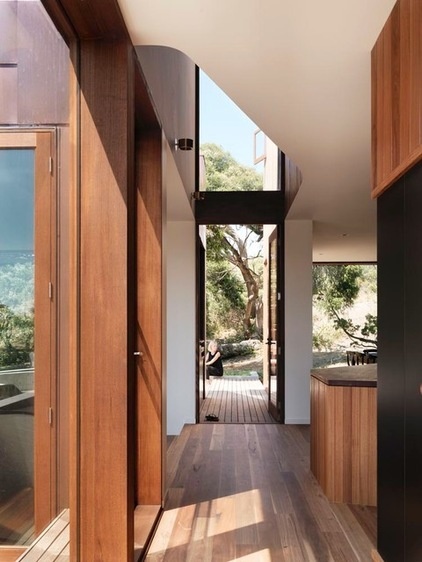
The front door opens into the kitchen and dining room on the second floor. Glass walls and windows lead straight to the rear of the house, framing one of the property’s many moonah trees.
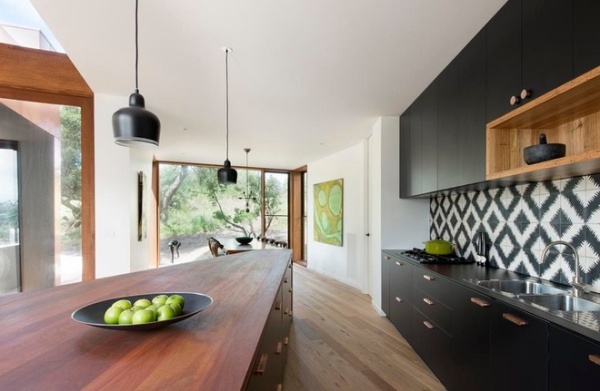
The family loves to cook and entertain friends, so the kitchen is spacious and central. Fitzpatrick avoided bringing in too many materials to compete with the irregular geometry of the house, as exemplified in the black, white and wood kitchen.
She used the same wood inside and outside and stuck with black and white for the home’s remaining finishes. Custom concrete backsplash tiles provide unexpected graphic interest, and the lighting was carefully selected for ambience.
Pendant lights: Alvar Aalto; flooring: solid spotted gum with a matte waterborne finish
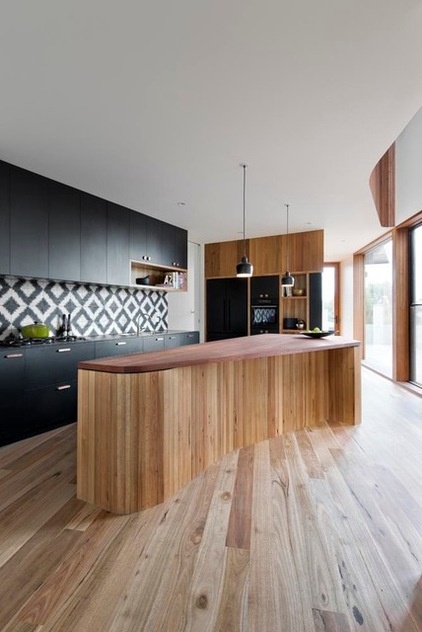
The island’s counter is solid wood, and the counter along the wall is black laminate. The cabinets are a combination of blackbutt (a popular Australian hardwood in the eucalyptus family), veneer and black laminate.
Brass and copper fixtures and fittings warm up the material palette. The kitchen cabinet handles are made of raw copper and were fabricated especially for this house. “We wanted to use copper to reference the external cladding, and we left it raw to patina over time along with the outside of the house,” says Fitzpatrick.
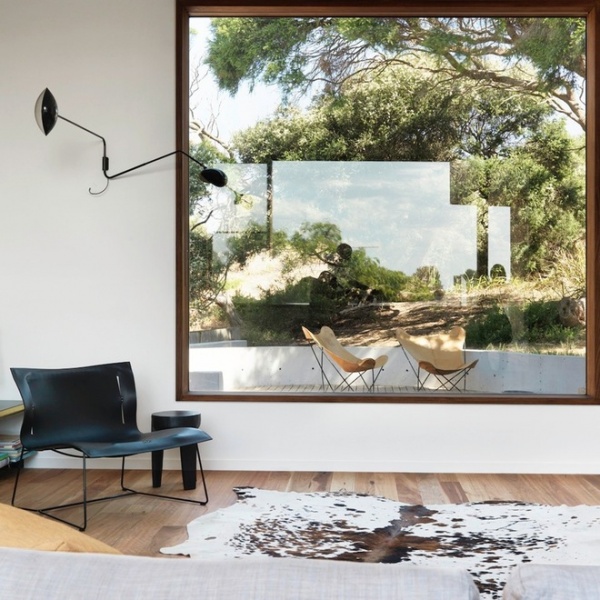
The living room overlooks the back deck. The window frames throughout the house are Victorian ash, an Australian hardwood, and have been stained to match the timber and copper lining. The window frames sit deep within the walls — up to 12 inches (300 millimeters). Fitzpatrick intended this detail to heighten awareness of the outdoor surroundings.
Lounge chair: Cuoio Lounge, Eoos; wall sconce: custom
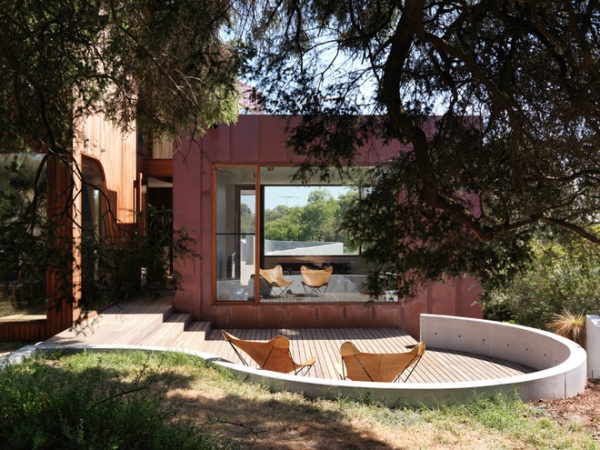
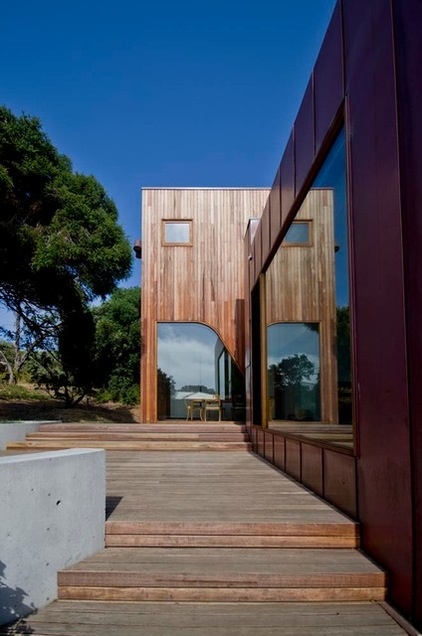
Unusual shapes and angles abound in this bluff house. The home’s clean yet complex geometry comes from extensive studies and design processes, avoiding a disjointed and unbalanced structure. “We wanted a sculptural and stylized form that would sit comfortably in the natural landscape,” says Fitzpatrick. The sculptural forms of the trees themselves inspired some of these curves.
The home’s surrounding decks are as integral to the house as the rooms themselves. A year-round temperate climate often means more living outside. The deck is solid spotted gum timber, the same material as the flooring inside.
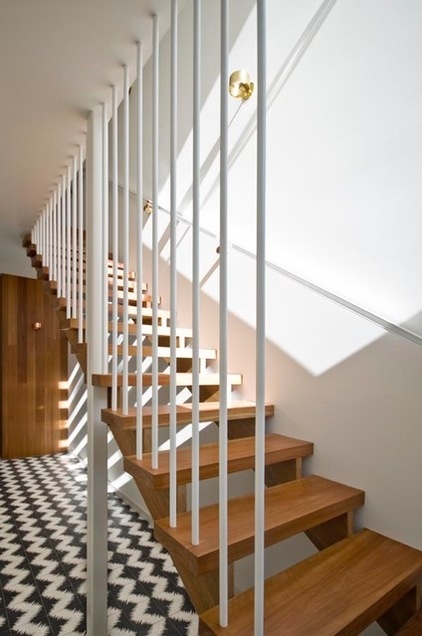
From the second floor, the main living floor, this cantilevered staircase descends to the first floor. It is made from solid slabs of spotted gum timber. The architects left the risers open to allow more light to penetrate that lower level. The wall-mounted railing and guardrail are made from powder-coated steel. This level is used in the summer when the homeowners’ children visit.
The same concrete tiles from the backsplash are used on the first floor.
Builder: Ashely Crowe Builders
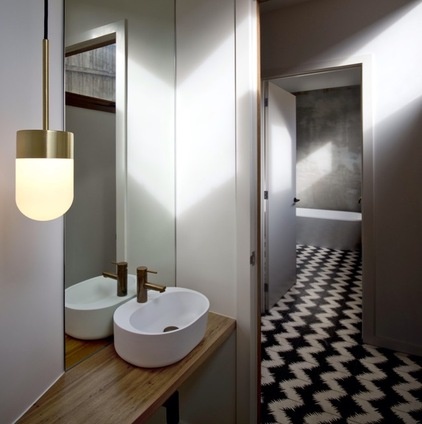
The bathroom counters are solid blackbutt timer, and the cabinets are blackbutt veneer.
Pendant light: Vox, Ruben Lighting
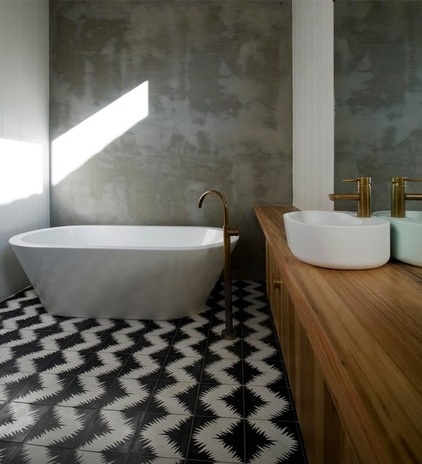
Unlike the top floors, this bottom floor has only clerestory windows. But “the changing light and shadow play throughout the day brings a new dimension to the interior spaces,” says Fitzpatrick — always connecting the indoors with outside.
Freestanding bathtub: Kado; sink: Omvivo; fixtures: Icon collection, Astra Walker
More: Modern Treetop Living in Sydney












